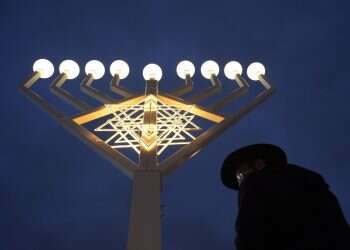"The Western Wall doesn't belong to the Jews alone," Labor party leader Avi Gabbay said last week before rushing to walk it back. But maybe we should thank him. The party leader gave us a chance to address another perversion of history, this one intentional – the Palestinian Islamization of the Western Wall – the holy site they long for as one of the walls of Al-Aqsa compound – by categorically denying any Jewish ties to it, just like they do with the Temple Mount and Jerusalem as a whole.
Embarrassingly, good Jews who are fighting for the place of the Jewish people and the State of Israel on the Temple Mount are unaware that they are helping the Muslim perversion. They want so badly to elevate the status of the Mount that they minimize the Western Wall, even going so far as to deny its holiness, and sometimes even holding it in contempt. One such activist recently called it "a meaningless wall" and "a rear parking place for horses and camels."
We need to put things straight. The Western Wall became the central place for Jewish prayer in Jerusalem following the earthquake that shook the city in 1546. The earthquake brought down the buildings that had stood flush up against the Western Wall, in what today is the well-known prayer plaza, and allowed the Turks to allot the Jews a narrow passageway for their prayers.
But despite the contemptuous remarks by those who deny the Western Wall's status (both Jewish and Muslim), this was no "invention" of the past few hundred years. Historic sources show that from the moment the Muslim occupiers allowed the Jews back into Jerusalem, over 1,000 years ago (after the Christians had barred them from the city), they would pray all along the length of the Western Wall, much of which was free of Muslim construction, unlike today. Jews prayed at the southern corner of the wall, as well as its northern sections – near the Cotton, Iron, and Council (Majlis) gates. Until Jerusalem fell to the Crusaders in 1099, a synagogue known as "the cave" operated in an underground space beneath Warren's Gate in the Western Wall.
"The cave" was located exactly opposite where the Holy of Holies was believed to have stood, in the middle of the Dome of the Rock, where the Foundation Stone rests. The Western Wall became the preferred choice because it was closer to that place than any of the other walls of the Temple Mount. A series of midrashim dating back 1,500 years and more gives the Western Wall continual sanctity because of this proximity.
The Muslims call the Western Wall "Al-Buraq," after the Prophet Muhammad's magical horse. They point to the wall as the place where their prophet tied up his winged horse in his dream of a night journey from Mecca to Jerusalem.
The identification of the Western Wall as the place where the winged horse was tied up was created when the Zionist movement was coming into being, and gained traction during the conflict over the Western Wall in the 1920s. It was the Muslim response to the strengthening Jewish presence in the Holy Land, especially in Jerusalem and at the Western Wall.
The Muslims went to great lengths to desecrate the place by marching donkeys, horses, and camels past it and intentionally throwing out animal waste there. They broke through the wall from the Temple Mount compound and held noisy ceremonies intended to keep the Jews from praying at the wall.
Today, they are claiming that the Western Wall is holy to them, but they erected homes and outhouses in front of it and ran sewer pipes along it, as well as water and electricity hookups. The "Little Western Wall" section, which lies in the heart of the Muslim Quarter, is frequently defaced with graffiti and public urination and used as a trash heap. Sometimes Muslims use it as a climbing wall. This is not how a religion treats a place it claims is holy. The obvious conclusion is that this is a case of false sanctification – a tool designed to keep us away from the Western Wall, like the ongoing attempt to oust us from other parts of Jerusalem and the land of Israel.
Gabbay was wrong, God forgive him. The Western Wall is holy only to Jews – not to Christians or Muslims. The Temple Mount, on the other hand, the place where the Jewish Temple stood and on the ruins of which the Muslims built their houses of prayer – is holy to Muslims, as well.
The wall at the foot of the Mount is not "an unimportant wall" – it is a corridor that absorbs the holiness of the Temple Mount itself.



